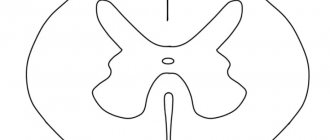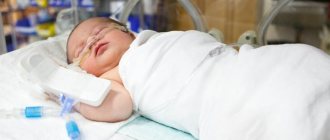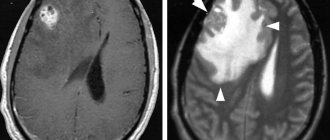Among mild forms of childhood neuropsychiatric disorders, minimal brain dysfunction (MCD) occupies a special place.
This pathology manifests itself in the form of disturbances in speech, behavior, and motor functions. Despite the fact that psychiatrists designate MMD as a mild disorder, it requires mandatory professional support. This is the only way to guarantee the child’s successful adaptation to school and his assimilation of knowledge, which will then allow him to continue his education at a higher educational institution.
Manifestations of pathology
The first signs of a pathology such as minimal brain dysfunction in children can be noticed at a very early age. A modified shape of the skull and ears, deviations from the norm in the structure of the palate and tooth growth - all of these are visual manifestations of MMD in children.
The clinical picture of the pathology is quite extensive. It can have a variety of manifestations:
- autonomic disorders. These include excessive sweating, marbling of the skin, malfunction of the gastrointestinal tract (stool instability, frequent fluctuations in constipation and diarrhea), unstable pulse and functioning of the cardiovascular system;
- weak muscle tone and movement disorders. Muscle tone may be uneven, there is asymmetry of tendon reflexes, and lack of fine motor skills. It is especially difficult for such children to fasten buttons or tie shoelaces, and they have difficulty working with scissors, drawing with a pencil, or writing with a pen. Due to the fact that the facial muscles are also weakened, the child’s facial expressions are quite poor, he almost never makes faces or grimaces. Children with MMD have difficulty catching a ball, riding a bicycle, or walking in a straight line;
- The disorder also affects the behavior of children. Usually such kids are very active, they are restless, easily distracted, and find it difficult to concentrate on completing the assigned task;
- unstable emotional background. Children experience frequent mood swings.
Minimal brain dysfunction is accompanied by a high degree of depletion of nerve cells located in the upper layers of the cerebral cortex. The consequence of this is rapid fatigue, and certain difficulties arise with memory and the formation of a stock of general concepts. All this leads to mental and speech delays in development.
Children with MMD also experience difficulties in the social sphere. They find it easier to find a common language with children who are younger than them in age, while excessive excitability and a tendency to create conflict situations do not allow them to establish contacts with peers within the walls of preschool educational institutions. Such children may have problems falling asleep, they often toss and turn in their sleep, and most of them suffer from urinary incontinence.
Gradually, as the baby gets older, the clinical manifestations of the disorder disappear without a trace. According to statistics, in early preschool age, MMD is observed in approximately every fifth of children, and already in the elementary grades, the pathology can be found in one in 20 students. But this is only possible if special attention is paid to the upbringing and education of a child with MMD. Only in very rare cases do some of the symptoms of the disorder persist into adulthood.
Causes
The main cause of the development of MMD is considered to be organic damage to the cerebral cortex or a developmental abnormality. Various infections, somatic diseases of the mother that are in the acute stage, poor nutrition of a pregnant woman, various pathologies of pregnancy, taking certain medications, drinking alcohol, drugs and smoking can have a negative impact on the formation of the central nervous system of the fetus.
Various traumas inflicted on the child at the time of his birth can also lead to the development of this disorder. In addition, pathology can be provoked by such factors as mild labor and subsequent stimulation with special means, rapid labor, surgical delivery, fetal hypoxia, incomplete dilation of the birth canal in a woman, an overly large fetus, as well as the use of special obstetric instruments by medical staff (obstetric forceps, vacuum extractor, etc.).
Neuroinfections and injuries that lead to damage to the central nervous system can lead to the development of MMD in the neonatal period. If the disorder develops between the ages of 3 and 6 years, then its cause is most likely pedagogical and social neglect. Such a condition of a child is a result of being raised in a dysfunctional family.
Diencephalic dysfunction
First of all, it affects the intermediate parts of the brain, or rather, begins to affect them. When observing such a disorder, a person experiences:
- decreased sensitivity in the body.
- a decrease in the pain threshold, as well as the development of thalamic pain.
- intention tremor.
- a quick and causeless change from tears to laughter and vice versa.
- endocrine disorders.
This dysfunction is considered one of the most common diseases that characterize neurology. Usually the most striking representative is vegetative-vascular dystonia. The disease occurs in a third of the population and is especially common in women.
Dysfunction is treated with various medications and radiotherapy. Special diets may sometimes be used for medicinal purposes.
Diagnostic features
In order to diagnose MMD in children, the doctor must conduct a comprehensive examination using currently available research methods.
When examining infants, specialists first of all pay attention to reflexes, as well as the symmetry of their expression. At the age of 3 to 6 years, the doctor can already track the dynamics of clinical manifestations, as well as their severity. When working with schoolchildren, psychodiagnostic methods are used, since an objective examination at this age does not provide a complete picture of the pathology.
Minimal brain dysfunction in children is diagnosed using the Gordon system, Wechsler test, Luria-90, etc. These methods enable a doctor (pediatrician or neurologist) to assess the degree of development of the child and his mental state, as well as identify behavioral characteristics.
Of the instrumental methods, the most informative in diagnosing MMD are computed and magnetic resonance imaging, echoencephalography, neurosonography and others. Routine clinical tests do not reveal any abnormalities. Tomography allows us to determine a decrease in the cerebral cortex in the region of the crown and left side of the forehead, damage to the anterior region (medial and ophthalmic), as well as a significant decrease in the size of the cerebellum. The use of x-rays can help rule out skull fractures.
When diagnosing minimal brain dysfunction in children, a differential approach is used. This depends, first of all, on the age of the child, as well as on the moment at which the primary symptoms appeared. During diagnostic measures, it will be necessary to exclude traumatic brain injury, neuroinfections, cerebral palsy, epilepsy and diseases similar to it, schizophrenia, acute poisoning with heavy metals (lead) and other pathologies that have similar manifestations.
When it poses a danger
If a patient has a head injury and at the same time there are disorders such as loss of consciousness, circulatory and respiratory processes work intermittently, then this may directly indicate, even without additional examinations, that there is dysfunction of the stem structures.
Also in another case, when the patient did not have a head injury, but symptoms manifested in disturbances of consciousness, the presence of seizures or damage to the nerves of the skull. In such situations, the doctor may perform an EEG. There is a high probability that this examination will reveal symptoms indicating irritation of the brain stem. Then the doctor faces the task of establishing the causes of irritation. For this purpose, CT or MRI may be prescribed. This form will allow us to identify, for example, a neoplasm that compresses or displaces the stem structure. Which, accordingly, is the cause of the appearance of these symptoms. Both situations are dangerous for the patient and require prompt intervention.
Brainstem dysfunction poses a serious danger. As already mentioned, the trunk has respiratory and circulatory centers that are important for ensuring vital functions; in addition, it contains cranial nerves with nuclei. Dysfunction of these brain structures often provokes the development of:
- Dysphonia, that is, weakness of the voice.
- Speech disorders, or dysarthria, when something like chewing porridge occurs in the mouth.
- Dysphagia, which is expressed in failures of the swallowing process.
When a lesion forms in the trunk, this leads in some cases to paralysis and damage to the nerves of the brain in others.
Selection of treatment regimen
Correcting minimal brain dysfunction in children requires an integrated approach. Usually, an individual program is drawn up for each child, which takes into account the characteristics of the clinical picture and etiology.
MMD therapy is carried out in several areas:
- Pedagogical methods help minimize the consequences of social and pedagogical neglect and promote the child’s adaptation to the team. Social educators work not only with the child, but also with his parents. They advise encouraging the child, focusing on his successes and achievements, using the words “no” and “no” less, talking to the child with restraint, calmly and gently. Watching TV and playing on the computer should take no more than 40-60 minutes a day. Preference should be given to such games and activities that involve attention and concentration (puzzles, construction sets, drawing, etc.).
- Psychotherapeutic methods are aimed at correcting mental retardation. A psychologist and psychotherapist chooses ways to influence his little patient based on his age. If the child is still too young to contact the doctor, then the work is carried out mainly with his parents. It is necessary that a positive psychological microclimate be established in the family - the outcome of treatment largely depends on this.
- Drug treatment is prescribed extremely rarely. Taking medications allows you to relieve individual symptoms, for example, sleeping pills help normalize sleep, sedatives help calm an overly excitable baby, etc. In some cases, stimulants, tranquilizers and antidepressants may be recommended.
- Physiotherapy can improve the functioning of the nervous system, both central and peripheral, as well as restore their functioning as much as possible. The most effective in correcting this type of disorder are various types of massage, hydrokinesitherapy, and a set of therapeutic exercises. Sports activities such as running, cycling or skiing, as well as swimming will be useful. During sports activities, the child must concentrate and show dexterity, and this also has a positive effect on the treatment process for MMD.
Experts in most cases give positive prognoses for children with MMD. Approximately 50% of patients “outgrow” their disease, and in adolescence and adulthood the symptoms of the pathology disappear completely. However, in a number of patients, some of the manifestations of the disease remain for life.
People with MMD are characterized by inattention and impatience, they have difficulty communicating with people around them, they often have problems in their personal lives and when trying to create a full-fledged family, and it is difficult for them to learn professional skills.
Dysfunction of midline brain structures
The work of this department is aimed at the proper functioning of the autonomic nervous system in the human body. Dysfunction of the midline structures of the brain is characterized by disruption of night sleep and a person’s psycho-emotional state. This usually happens due to various types of injuries that occur as a result of a fall, blow, or during rehabilitation after them.
Symptoms of dysfunction of nonspecific midline structures are characterized by the following facts:
- decreased sensitivity (this is observed on the face or torso).
- decreased sensitivity to pain.
- rapidly changing crying or laughing.
- rapid puberty.
- endocrine disorders.
When diagnosing dysfunctions of the midline structures of the brain and prescribing treatment, the neurologist must take into account the characteristics of conscious and unconscious behavior and human health in order for the therapy to be as effective as possible.
Tips for parents
As noted above, the success of treatment largely depends on the psychological environment in which the child grows and is raised. He needs special attention from parents and teachers. Specialists of various specialties should work with the baby: psychologist, linguist and speech therapist, osteopath, neurologist, etc.
Of course, healthy children also need to be constantly raised and taught, but children with MMD need this especially. Compliance with the following recommendations will allow you to achieve full recovery as soon as possible:
- strict adherence to the daily routine. First of all, this disciplines the child, but developing a habit in the child to regularly perform certain actions also allows you to synchronize the work of the central nervous system with the entire body;
- normal sleep. Children aged 3 to 6 years should sleep 10 hours a day. This time is divided into daytime sleep (2 hours) and night sleep (8 hours). If your baby cannot sleep, then try to keep him busy during the day with active games in the fresh air and sports activities;
- dispensing new material. The child will not be able to immediately absorb all the material provided by the educational program. Try to break it down into several parts, and present new information in doses at short intervals. Ask your child to repeat the material covered more often;
- Children with MMD need movement, since one of the manifestations of this pathology is underdevelopment of muscles, including the diaphragm. With prolonged absence of movement, the body begins to experience oxygen starvation. Therefore, do not force a child with minimal brain dysfunction to sit still for a long time - this will make it difficult for him to breathe;
- try to develop your child creatively. Activities during which the child uses imagination stimulate the development of imaginative thinking, which means the brain comes into a state of activity. Researchers have observed that the creative development of children with MMD contributes to better mastery of exact sciences;
- friendly atmosphere in the family. Try to protect your child from various stressful situations; he should not be subjected to psychological pressure. Children with MMD often suffer from bullying from peers at school, and for treatment to be successful, it is necessary to try to avoid such conflicts. Healing will be achieved only if the baby’s body itself begins to correct deviations; this can only be achieved in a favorable psychological environment, not only at home, but also at school.
To prevent the development of minimal brain dysfunction, it is necessary to pay special attention to the nutrition of the expectant mother. In addition, she must completely give up bad habits. Regular visits to the antenatal clinic will allow doctors to treat concomitant diseases, eliminate the possibility of developing pregnancy pathologies, and also choose the most suitable method of delivery.
A specialist can diagnose minimal brain dysfunction if the baby exhibits several of the symptoms of the disease for a long time. But if your child’s behavior seems strange to you, you notice that he has conflicts with peers, and it is difficult for him to remember new information, then be sure to consult a doctor: a psychologist, psychotherapist, neurologist or neurologist. Even if he is not diagnosed with a psychological disorder, advice from a specialist will help normalize his behavior and solve other problems.









